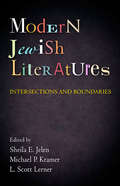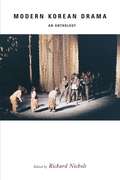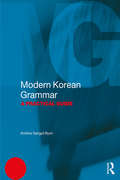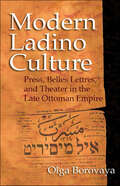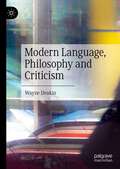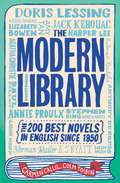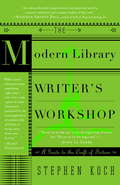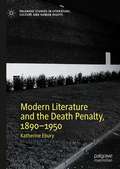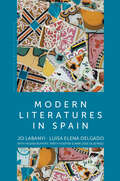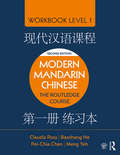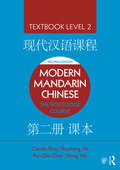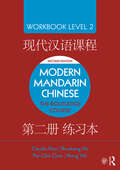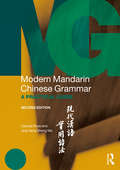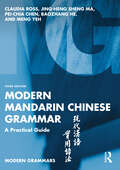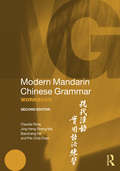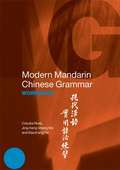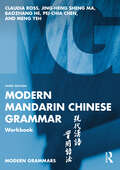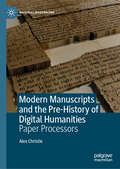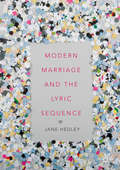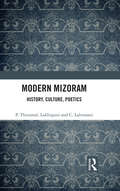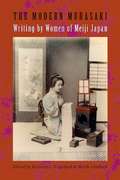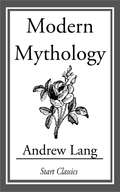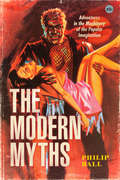- Table View
- List View
Modern Jewish Literatures: Intersections and Boundaries (Jewish Culture and Contexts)
by Sheila E. Jelen Michael P. Kramer L. Scott LernerIs there such a thing as a distinctive Jewish literature? While definitions have been offered, none has been universally accepted. Modern Jewish literature lacks the basic markers of national literatures: it has neither a common geography nor a shared language—though works in Hebrew or Yiddish are almost certainly included—and the field is so diverse that it cannot be contained within the bounds of one literary category.Each of the fifteen essays collected in Modern Jewish Literatures takes on the above question by describing a movement across boundaries—between languages, cultures, genres, or spaces. Works in Hebrew and Yiddish are amply represented, but works in English, French, German, Italian, Ladino, and Russian are also considered. Topics range from the poetry of the Israeli nationalist Natan Alterman to the Russian poet Osip Mandelstam; from turn-of-the-century Ottoman Jewish journalism to wire-recorded Holocaust testimonies; from the intellectual salons of late eighteenth-century Berlin to the shelves of a Jewish bookstore in twentieth-century Los Angeles.The literary world described in Modern Jewish Literatures is demarcated chronologically by the Enlightenment, the Haskalah, and the French Revolution, on one end, and the fiftieth anniversary of the State of Israel on the other. The particular terms of the encounter between a Jewish past and present for modern Jews has varied greatly, by continent, country, or village, by language, and by social standing, among other things. What unites the subjects of these studies is not a common ethnic, religious, or cultural history but rather a shared endeavor to use literary production and writing in general as the laboratory in which to explore and represent Jewish experience in the modern world.
Modern Korean Drama: An Anthology
by Richard NicholsCarefully selected and represented, the plays in this collection showcase both the fantastic and the realistic innovations of Korean dramatists during a time of rapid social and historical change. Stretching from 1962 to 2004, these seven works tackle major subjects, such as the close of the Choson dynasty and the aftermath of the Korean War, while delving into trenchant cultural issues, such as the marginalization of students who rebel against mainstream education and the role of traditional values in a materialistic society. Longtime scholar of Korea and its vibrant, politically acute theater, Richard Nichols opens with a general overview of modern Korean drama since 1910 and concludes with an appendix describing theater production and audience attendance in Seoul. He chooses works that aren't just for Korean audiences. These texts confront universal themes and situations, tackling the problem of ambition, the trouble with fidelity, and the complexity of sexual and interpersonal relationships. Nichols situates each work critically, historically, and culturally, including brief biographies of playwrights and extensive notes. A bibliography also provides alternative readings and the titles of additional plays currently available in English. Primed for production, these skillful translations provide Western directors with exciting new material for the stage. At the same time, they offer students and scholars a sophisticated survey of the modern Korean dramatic tradition.
Modern Korean Grammar: A Practical Guide (Modern Grammars)
by Andrew Sangpil ByonRoutledge’s Modern Grammar series is an innovative reference guide combining traditional and function-focused grammar in a single volume, with an accompanying workbook. The aim of the Modern Korean Grammar is to provide an overview of the structures and functions of the Korean language. Designed for those who have already acquired the basics of the language, the book combines a comprehensive description of the grammatical structures of Korean with a functional/usage approach to the language. All target grammatical and functional points will be illustrated with examples in Hangul with English translations for better understanding. In addition, the use of linguistic terminology is limited, to facilitate quick and easy comprehension.
Modern Ladino Culture: Press, Belles Lettres, and Theater in the Late Ottoman Empire (Sephardi and Mizrahi Studies)
by Olga BorovayaOlga Borovaya explores the emergence and expansion of print culture in Ladino (Judeo-Spanish), the mother tongue of the Sephardic Jews of the Ottoman Empire, in the second half of the 19th and early 20th centuries. She provides the first comprehensive study of the three major forms of Ladino literary production—the press, belles lettres, and theater—as a single cultural phenomenon. The product of meticulous research and innovative methodology, Modern Ladino Culture offers a new perspective on the history of the Ladino press, a novel approach to the study of belles lettres in Ladino and their relationship to their European sources, and a fine-grained critique of Sephardic plays as venues for moral education and politicization.
Modern Language, Philosophy and Criticism
by Wayne DeakinThis books delineates the seismic shifts of the twentieth century humanities by way of a close examination of the dynamic landscape of modern language, criticism and philosophy. In this manner, it argues that both philosophy and literary criticism have dovetailed in the twenty-first century. Starting out as a survey of literary criticism in its broadest terms, later chapters - which are more expository - assess recent movements within modern literary theory. These are located with respect to the post-Russell and Fregean “linguistic turn” in philosophy. Designed for specialists and non-specialists alike; philosophers, literary critics and even students of the modern critical tradition, the argument takes a novel stance towards modern criticism, language and philosophy, arguing for a return to a more formalist and rhetorical approach to literary criticism, while taking care not to indulge too many “political pathologies” when engaging with texts.
Modern Legal Drafting
by Peter ButtIn the second edition of this highly regarded text, the authors show how and why traditional legal language has developed the peculiar characteristics that make legal documents inaccessible to the end users. Incorporating recent research and case law, the book provides a critical examination of case law and the rules of interpretation. Detailed case studies illustrate how obtuse or outdated words, phrases and concepts can be rewritten, reworked or removed altogether. Particularly useful is the step-by-step guide to drafting in the modern style, using examples from four types of common legal documents: leases, company constitutions, wills and conveyances. Readers will gain an appreciation of the historical influences on drafting practice and the use of legal terminology. They will learn about the current moves to reform legal language, and receive clear instruction on how to make their writing clearer and their legal documents more useful.
The Modern Library: The 200 Best Novels in English Since 1950
by Carmen Callil Colm ToibinFor Colm Toíbín and Carmen Callil there is no difference between literary and commercial writing - there is only the good novel: engrossing, inspirational, compelling. In their selection of the best 200 novels written since 1950, the editors make a case for the best and the best-loved works and argue why each should be considered a modern classic. Enlightening, often unexpected and always engaging this tour through the world of fiction is full of surprises, forgotten masterpieces and a valuable guide to what to read next. Authors in the collection include Agatha Christie, Georgette Heyer, Daphne du Maurier, Patrick Hamilton, Carson McCullers, J. D. Salinger, Bernard Malamud; Flannery O'Connor, Mulk Raj Anand, Raymond Chandler, L. P. Hartley, Amos Tutuola, Sylvia Townsend Warner, Samuel Beckett, Patricia Highsmith, Chinua Achebe, Isak Dineson, Alan Sillitoe, Ivy Compton-Burnett, Grace Paley, Harper Lee, Olivia Manning and Mordecai Richler.
The Modern Library: The Two Hundred Best Novels In English Since 1950 (Brief Guide To... Ser.)
by Colm Toibin Carmen CallilFor Colm Toibin and Carmen Callil there is no difference between literary and commercial writing - there is only the good novel: engrossing, inspirational, compelling. In their selection of the best 200 novels written since 1950, the editors make a case for the best and the best-loved works and argue why each should be considered a modern classic. Enlightening, often unexpected, and always engaging this tour through the world of fiction is full of surprises, forgotten masterpieces and a valuable guide to what to read next. Authors include:Agatha Christie, Henry Green, Frank Hardy, Georgette Heyer, J. D. Salinger, Ralph Ellison, Ernest Hemingway, Bernard Malamud, R. K. Narayan, Flannery O'Connor, John Steinbeck, Evelyn Waugh, Mulk Raj Anand, James Baldwin, Saul Bellow, Raymond Chandler, L. P. Hartley, Rosamund Lehmann, Amos Tutuola, Kingsley Amis, William Golding, Elizabeth Jenkins, Sylvia Townsend Warner, Samuel Beckett, Patricia Highsmith, Vladimir Nabokov, Janet Frame, Jack Kerouac, Elizabeth Taylor, Rebecca West, Chinua Achebe, Olivia Manning, John Updike, P. G. Wodehouse, Joseph Heller, V. S. Naipaul, Muriel Spark, Patrick White, Maureen Duffy, William Faulkner, Doris Lessing, Edna O'Brien, Katherine Anne Porter, Elizabeth Bowen, John Le CarrÈ, Mary McCarthy, Sylvia Plath, Wilson Harris, Hubert Selby Jr., Frank Sargeson, Wole Soyinka, Margaret Laurence, Jean Rhys, Paul Scott, John Fowles, Christina Stead, William Styron, Ngugi Wa Thiong'o, William H. Gass,Iris Murdoch, B. S. Johnson, Mary Lavin, Mario Puzo, Robertson Davies, Patrick O'Brian, Eudora Welty, J. G. Farrell, Thomas Pynchon, E. L. Doctorow, Ruth Prawer Jhabvala, David Lodge, Alistair MacLeod, Graham Greene, Roy A. K. Heath, Ian McEwan, Thomas Flanagan, Martin Amis, J. G. Ballard, Julian Barnes, Anita Desai, Balraj Khanna, Cormac McCarthy, Raymond Carver, Frank Moorhouse, Bapsi Sidhwa, Anne Tyler, Tom Wolfe, John Banville, Oscar Hijuelos, Amy Tan, A. S. Byatt, J. M. Coetzee, Micheal Cunningham, Roddy Doyle, David Malouf, Alice Munro, Pat Barker, Angela Carter, Amit Chaudhuri, Bret Easton Ellis, Timothy Mo, Norman Rush, Iain Sinclair, Patrick McCabe, Donna Tartt, Jeffrey Eugenides, Gita Mehta, E. Annie Proulx, Will Self, Irvine Welsh, Sebastian Faulks, Vikram Seth, Jonathan Coe, Louis de BerniËres, Alan Hollinghurst, P. D. James, James Kelman, T. Coraghessan Boyle, Penelope Fitzgerald, Rohinton Mistry, Margaret Atwood, Patrick McGrath, Graham Swift, Tobias Wolff, Jim Crace, Don DeLillo, Philip Roth.
The Modern Library Writer's Workshop
by Stephen Koch“Make [your] characters want something right away—even if it’s only a glass of water. Characters paralyzed by the meaninglessness of modern life still have to drink water from time to time. ” —Kurt Vonnegut “‘The cat sat on the mat’ is not the beginning of a story, but ‘the cat sat on the dog’s mat’ is. ” —John Le Carré Nothing is more inspiring for a beginning writer than listening to masters of the craft talk about the writing life. But if you can’t get Vladimir Nabokov, Virginia Woolf, and Gabriel García Márquez together at the Algonquin,The Modern Library Writer’s Workshopgives you the next best thing. Stephen Koch, former chair of Columbia University’s graduate creative writing program, presents a unique guide to the craft of fiction. Along with his own lucid observations and commonsense techniques, he weaves together wisdom, advice, and inspiring commentary from some of our greatest writers. Taking you from the moment of inspiration (keep a notebook with you at all times), to writing a first draft (do it quickly! you can always revise later), to figuring out a plot (plot always serves the story, not vice versa), Koch is a benevolent mentor, glad to dispense sound advice when you need it most. The Modern Library Writer’s Workshopbelongs on every writer’s shelf, to be picked up and pored over for those moments when the muse needs a little help finding her way. From the Trade Paperback edition.
Modern Literature and the Death Penalty, 1890-1950 (Palgrave Studies in Literature, Culture and Human Rights)
by Katherine EburyThis book examines how the cultural and ethical power of literature allowed writers and readers to reflect on the practice of capital punishment in the UK, Ireland and the US between 1890 and 1950. It explores how connections between ‘high’ and ‘popular’ culture seem particularly inextricable where the death penalty is at stake, analysing a range of forms including major works of canonical literature, detective fiction, plays, polemics, criminological and psychoanalytic tracts and letters and memoirs. The book addresses conceptual understandings of the modern death penalty, including themes such as confession, the gothic, life-writing and the human-animal binary. It also discusses the role of conflict in shaping the representation of capital punishment, including chapters on the Easter Rising, on World War I, on colonial and quasi-colonial conflict and on World War II. Ebury’s overall approach aims to improve our understanding of the centrality of the death penalty and the role it played in major twentieth century literary movements and historical events.
Modern Literatures in Spain
by Jo Labanyi Luisa Elena DelgadoJo Labanyi and Luisa Elena Delgado provide the first cultural history of modern literatures in Spain. With contributors Helena Buffery, Kirsty Hooper, and Mari Jose Olaziregi, they showcase the country&’s cultural richness and complexity by working across its four major literary cultures – Castilian, Catalan, Galician, and Basque – from the eighteenth century to the present. Engaging critically with the concept of the &“national&”, Modern Literatures in Spain traces the uneven institutionalization of Spain&’s diverse literatures in a context of Castilian literary hegemony, as well as examining diasporic and exile writing . The thematically organized chapters explore literary constructions of subjectivity, gender, and sexuality; urban and rural imaginaries; intersections between high and popular culture; and the formation of a public sphere. Throughout, readings are attentive to the multiple ways in which literature serves as a barometer of cultural responses to historical change. An introduction to major cultural debates as well as an original analysis of key texts, this book is essential reading for students and scholars with an interest in the literatures and cultures of Spain.
Modern Mandarin Chinese: The Routledge Course Workbook Level 1 (Second Edition) (Modern Grammar Workbooks Ser.)
by Claudia Ross Baozhang He Pei-Chia Chen Meng Yeh<p>Modern Mandarin Chinese is a two-year undergraduate course for students with no prior background in Chinese study. Designed to build a strong foundation in both the spoken and written language, it develops all the basic skills such as pronunciation, character writing, word use, and structures, while placing a strong emphasis on the development of communicative skills. <p>Each level of the course consists of a textbook and workbook in simplified Chinese. A free companion website provides all the audio for the course with a broad range of interactive exercises and additional resources for students’ self-study, along with a comprehensive instructor’s guide with teaching tips, assessment and homework material, and a full answer key. <p>Key changes to this new edition: <p> <li>An increased number of vocabulary and characters introduced. 255 characters are introduced in this second edition for active production. Dialogues and example sentences are also presented in full-character format for passive recognition, and to provide additional challenge for more advanced students. <li>Additional exercises in the workbooks and online to support the expanded number of words and characters incorporated into the textbooks. <li>New cross-references between the textbooks, workbooks and companion website facilitate using all the resources in an integrated manner. <li>Greatly enhanced and re-designed website.</li> <p> <p>Retaining its focus on communicative skills and the long-term retention of characters, the text is now presented in simplified characters and pinyin from the outset with a gradual and phased removal of pinyin as specific characters are introduced and learnt. This unique approach allows students to benefit from the support of pinyin in the initial stages as they begin speaking while ensuring they are guided and supported towards reading only in characters.</p>
Modern Mandarin Chinese: The Routledge Course Textbook Level 2
by Claudia Ross Baozhang He Pei-Chia Chen Meng YehModern Mandarin Chinese is a two-year undergraduate course for students with no prior background in Chinese study. Designed to build a strong foundation in both the spoken and written language, it develops all the basic skills such as pronunciation, character writing, word use, and structures, while placing a strong emphasis on the development of communication skills. Each level of the course consists of a textbook and workbook in simplified characters. A free companion website provides all the audio for the course with a broad range of interactive exercises and additional resources for students’ self-study, along with a comprehensive instructor’s guide with teaching tips, assessment and homework material, and a full answer key. Key changes to this new edition: This revised edition of level 2 introduces over 200 characters and over 400 new vocabulary items. Additional exercises in the workbooks and online support the expanded number of words and characters incorporated into the textbooks. New cross-references between the textbooks, workbooks, and companion website facilitate using all the resources in an integrated manner. The website has been redesigned and greatly enhanced. Retaining its focus on communicative skills and the long-term retention of characters, the text is presented in simplified characters and pinyin with a gradual and phased removal of pinyin as specific characters are introduced and learned. This approach allows students to focus on the pronunciation and meaning of new words before the corresponding characters are introduced, ensuring they are guided and supported towards reading only in characters.
Modern Mandarin Chinese: The Routledge Course Workbook Level 2
by Claudia Ross Baozhang He Pei-Chia Chen Meng YehModern Mandarin Chinese is a two-year undergraduate course for students with no prior background in Chinese study. Designed to build a strong foundation in both the spoken and written language, it develops all the basic skills such as pronunciation, character writing, word use, and structures, while placing strong emphasis on the development of communicative skills. Each level of the course consists of a textbook and workbook in simplified characters. A free companion website provides all the audio for the course with a broad range of interactive exercises and additional resources for students’ self-study, along with a comprehensive instructor’s guide with teaching tips, assessment and homework material, and a full answer key. Key changes to this new edition: • This revised edition of level 2 introduces over 200 characters and over 400 new vocabulary items. • Additional exercises in the workbooks and online support the expanded number of words and characters incorporated into the textbooks. • New cross-references between the textbooks, workbooks, and companion website facilitate using all the resources in an integrated manner. • The website has been redesigned and greatly enhanced. Retaining its focus on communicative skills and the long-term retention of characters, the text is presented in simplified characters and pinyin with a gradual and phased removal of pinyin as specific characters are introduced and learned. This approach allows students to focus on the pronunciation and meaning of new words before the corresponding characters are introduced, ensuring they are guided and supported towards reading only in characters.
Modern Mandarin Chinese Grammar: A Practical Guide (Modern Grammars)
by Claudia Ross Jing-heng Sheng MaModern Mandarin Chinese Grammar provides an innovative reference guide to Mandarin Chinese, combining traditional and function-based grammar in a single volume. The Grammar is divided into two parts. Part A covers traditional grammatical categories such as phrase order, nouns, verbs and specifiers. Part B is carefully organized around language functions and notions such as: Communication strategies Making comparisons Giving and seeking information Expressing apologies, regrets and sympathies The two parts of the Grammar are closely linked by extensive cross-references, providing a grammatical and functional perspective on many patterns. All grammar points and functions are richly illustrated with examples, with a strong focus on contemporary usage. Main features of the grammar include: Examples given in simplified characters, traditional characters and romanization (pinyin) Clear explanations and accessible descriptions Particular attention to areas of particular difficulty for learners of Mandarin Chinese Implementing feedback from users of the first edition of the Grammar, this second edition has been revised throughout to offer expanded explanations, examples, cross-referencing, and indexing and brand new chapters on aspect, resultative verbs, directional verbs and "ba" sentences. This is the ideal reference grammar for learners of Mandarin Chinese at all levels, from elementary to advanced. No prior knowledge of grammatical terminology is assumed and a glossary of grammatical terms is provided. This Grammar is accompanied by the Modern Mandarin Chinese Grammar Workbook (978-0-415-83488-9; available for separate purchase) which features related exercises and activities.
Modern Mandarin Chinese Grammar: A Practical Guide (Modern Grammars)
by Claudia Ross Jing-heng Sheng Ma Pei-Chia Chen Baozhang He Meng YehModern Mandarin Chinese Grammar: A Practical Guide, third edition, is an innovative reference guide to Mandarin Chinese, combining traditional and function-based grammar in a single volume. The Grammar is divided into two parts. Part A covers traditional grammar points such as phrase order, and the structure of noun phrases and verb phrases. Part B is carefully organized around language functions and situations such as: • Asking questions • Communication strategies • Making comparisons • Giving orders and making requests • Expressing apologies, regrets, and sympathy The two parts of the Grammar are closely linked by extensive cross-references, providing a grammatical and functional perspective on many patterns. The Grammar is coordinated with the Workbook, which provides grammar-focused and situation-focused exercises to facilitate practice and reinforce language use. All grammar points and functions are richly illustrated with examples presented in simplified and traditional characters and Pinyin romanization, with a strong emphasis on contemporary usage. This third edition includes new sections on character structure, social media, speaker perspective, and more, as well as updated illustrative sentences and an expanded index. Modern Mandarin Chinese Grammar is ideal for all learners of Mandarin Chinese, from beginner to intermediate and advanced students.
Modern Mandarin Chinese Grammar Workbook (Modern Grammar Workbooks)
by Claudia Ross Baozhang He Pei-Chia Chen Jing-Heng Sheng MaModern Mandarin Chinese Grammar Workbook is a book of exercises and language tasks for all learners of Mandarin Chinese. Divided into two sections, the Workbook initially provides exercises based on essential grammatical structures, and moves on to practice everyday functions such as making introductions, apologizing and expressing needs. With an extensive answer key at the back to enable students to check on their progress, main features include: exercises at various levels of challenge for a broad range of learners cross-referencing to the related Modern Mandarin Chinese Grammar a comprehensive index to exercises alphabetically arranged in terms of structures, functions, and key Chinese structure vocabulary. This second edition also offers a revised and expanded selection of exercises including new task-based exercises. Modern Mandarin Chinese Grammar Workbook is ideal for all learners of Mandarin Chinese, from beginner to intermediate and advanced students. It can be used both independently and alongside the Modern Mandarin Chinese Grammar (978-0-415-82714-0), which is also published by Routledge.
Modern Mandarin Chinese Grammar Workbook
by Claudia Ross Jing-Heng Sheng Ma Baozhang HeModern Mandarin Chinese Grammar Workbook is a book of exercises and language tasks for all learners of Mandarin Chinese. Divided into two sections, the Workbook initially provides exercises based on essential grammatical structures, and moves on to practise everyday functions such as making introductions, apologizing and expressing needs. With a comprehensive answer key at the back to enable students to check on their progress, main features include: exercises graded according to level of difficulty cross-referencing to the related Modern Mandarin Chinese Grammar topical exercises that develop students' vocabulary base. Modern Mandarin Chinese Grammar Workbook is ideal for all learners of Mandarin Chinese, from beginner to intermediate and advanced students. It can be used both independently and alongside the Modern Mandarin Chinese Grammar.
Modern Mandarin Chinese Grammar Workbook (Modern Grammar Workbooks)
by Claudia Ross Jing-Heng Sheng Ma Baozhang He Pei-Chia Chen Meng YehModern Mandarin Chinese Grammar Workbook, third edition, is a book of exercises and language tasks to facilitate practice and reinforce language use. Divided into two sections, the Workbook initially provides exercises based on essential grammatical structures, and moves on to practice everyday functions such as making introductions, apologizing, and expressing needs. With an extensive answer key at the back to enable students to check on their progress, main features include: Exercises at various levels of challenge for a broad range of learners Cross-referencing to the related Modern Mandarin Chinese Grammar A comprehensive index to exercises alphabetically arranged in terms of structures, functions, and key Chinese structure vocabulary This third edition also offers a revised and expanded selection of exercises including new task-based exercises. Modern Mandarin Chinese Grammar Workbook is ideal for all learners of Mandarin Chinese, from beginner to intermediate and advanced students. It can be used both independently and alongside Modern Mandarin Chinese Grammar, which is also published by Routledge.
Modern Manuscripts and the Pre-History of Digital Humanities: Paper Processors (Material Modernisms)
by Alex ChristieWhile text processing is often associated with the digital humanities, it is still seen as worlds apart from literary modernism and its aesthetic preoccupations. This book upsets that narrative. Examining literary manuscripts from some of the twentieth century's best-known and lesser-known novelists, from Marcel Proust to Mina Loy, Alex Christie reveals where authors experimented with proto-digital writing methods by hand. Instead of looking to computers as sources of inspiration, the authors discussed turned to twentieth-century media for their ability to reveal new layers of the material world. From analog fantasies of contacting the dead to digital anxieties of invisible information, the aesthetic ambitions of these novels can be traced back to their author's interest in emerging media devices and their technical operation. To capture the magic of such devices through writing, these authors devised radical methods for generating literary text, anticipating today's digital humanities.
Modern Marriage and the Lyric Sequence
by Jane HedleyModern Marriage and the Lyric Sequence investigates the ways in which some of our best poets writing in English have used poetic sequences to capture the lived experience of marriage. Beginning in 1862 with George Meredith’s Modern Love, Jane Hedley’s study utilizes the rubrics of temporality, dialogue, and triangulation to bring a deeply rooted and vitally interesting poetic genre into focus. Its twentieth- and twenty-first-century practitioners have included Edna St. Vincent Millay, Robert Lowell, Rita Dove, Eavan Boland, Louise Glück, Anne Carson, Ted Hughes, Claudia Emerson, Rachel Zucker, and Sharon Olds. In their poetic sequences the flourishing or failure of a particular marriage is always at stake, but as that relationship plays out over time, each sequence also speaks to larger questions: why we marry, what a marriage is, what our collective stake is in other people’s marriages. In the book’s final chapter gay marriage presents a fresh testing ground for these questions, in light of the US Supreme Court’s affirmation of same-sex marriage.
Modern Mizoram: History, Culture, Poetics
by P. Thirumal Laldinpuii C. LalrozamiMizoram is situated at a unique cusp in North East India, in terms of both physical and social contexts. It shares its borders with Myanmar and Bangladesh, while cultural influences range from the indigenous to the Western. This book offers an alternative understanding of the modern history of Mizoram through an analysis of its cultural practices through language, music, poetry and festivals. It explores the roots of modern cultural works not just in Christianity, but also in precolonial Mizo traditional practices. The authors closely examine text, performance and sculptural images, including the first handwritten newspaper Mizo Chanchin Laisuih (1898) and the Puma Zai festival (1907–11) from the early colonial period along with a contemporary sculptural image. They argue that cultural works open up to new forms of interpretations and responses over time. The book indicates that the Mizo creative sensibility enmeshed in theological, capitalistic-material and political/ideological regimes informs its modern enclosures, be it region, religion or nation. This book will be of great interest to scholars and researchers of cultural studies, literature, media, history, politics, sociology and social anthropology, area studies, North East India studies and South Asian studies.
The Modern Murasaki: Writing by Women of Meiji Japan (Asia Perspectives: History, Society, and Culture)
by Melek Ortabasi Rebecca CopelandThe first anthology of its kind, The Modern Murasaki brings the vibrancy and rich imagination of women's writing from the Meiji period to English-language readers. Along with traditional prose, the editors have chosen and carefully translated short stories, plays, poetry, speeches, essays, and personal journal entries. Selected readings include writings by the public speaker Kishida Toshiko, the dramatist Hasegawa Shigure, the short-fiction writer Shimizu Shikin, the political writer Tamura Toshiko, and the novelists Miyake Kaho, Higuchi Ichiyo, Tazawa Inabune, Kitada Usurai, Nogami Yaeko, and Mizuno Senko. The volume also includes a thorough introduction to each reading, an extensive index listing historical, social, and literary concepts, and a comprehensive guide to further research.The fierce tenor and bold content of these texts refute the popular belief that women of this era were passive and silent. A vital addition to courses in women's studies and Japanese literature and history, The Modern Murasaki is a singular resource for students and scholars.
Modern Mythology
by Andrew LangIt may well be doubted whether works of controversy serve any useful purpose. 'On an opponent,' as Mr. Matthew Arnold said, 'one never does make any impression,' though one may hope that controversy sometimes illuminates a topic in the eyes of impartial readers. The pages which follow cannot but seem wandering and desultory, for they are a reply to a book, Mr. Max Muller's Contributions to the Science of Mythology, in which the attack is of a skirmishing character. Throughout more than eight hundred pages the learned author keeps up an irregular fire at the ideas and methods of the anthropological school of mythologists. The reply must follow the lines of attack.
The Modern Myths: Adventures in the Machinery of the Popular Imagination
by Philip BallWith The Modern Myths, brilliant science communicator Philip Ball spins a new yarn. From novels and comic books to B-movies, it is an epic exploration of literature, new media and technology, the nature of storytelling, and the making and meaning of our most important tales. Myths are usually seen as stories from the depths of time—fun and fantastical, but no longer believed by anyone. Yet, as Philip Ball shows, we are still writing them—and still living them—today. From Robinson Crusoe and Frankenstein to Batman, many stories written in the past few centuries are commonly, perhaps glibly, called “modern myths.” But Ball argues that we should take that idea seriously. Our stories of Dracula, Dr. Jekyll and Mr. Hyde, and Sherlock Holmes are doing the kind of cultural work that the ancient myths once did. Through the medium of narratives that all of us know in their basic outline and which have no clear moral or resolution, these modern myths explore some of our deepest fears, dreams, and anxieties. We keep returning to these tales, reinventing them endlessly for new uses. But what are they really about, and why do we need them? What myths are still taking shape today? And what makes a story become a modern myth? In The Modern Myths, Ball takes us on a wide-ranging tour of our collective imagination, asking what some of its most popular stories reveal about the nature of being human in the modern age.
